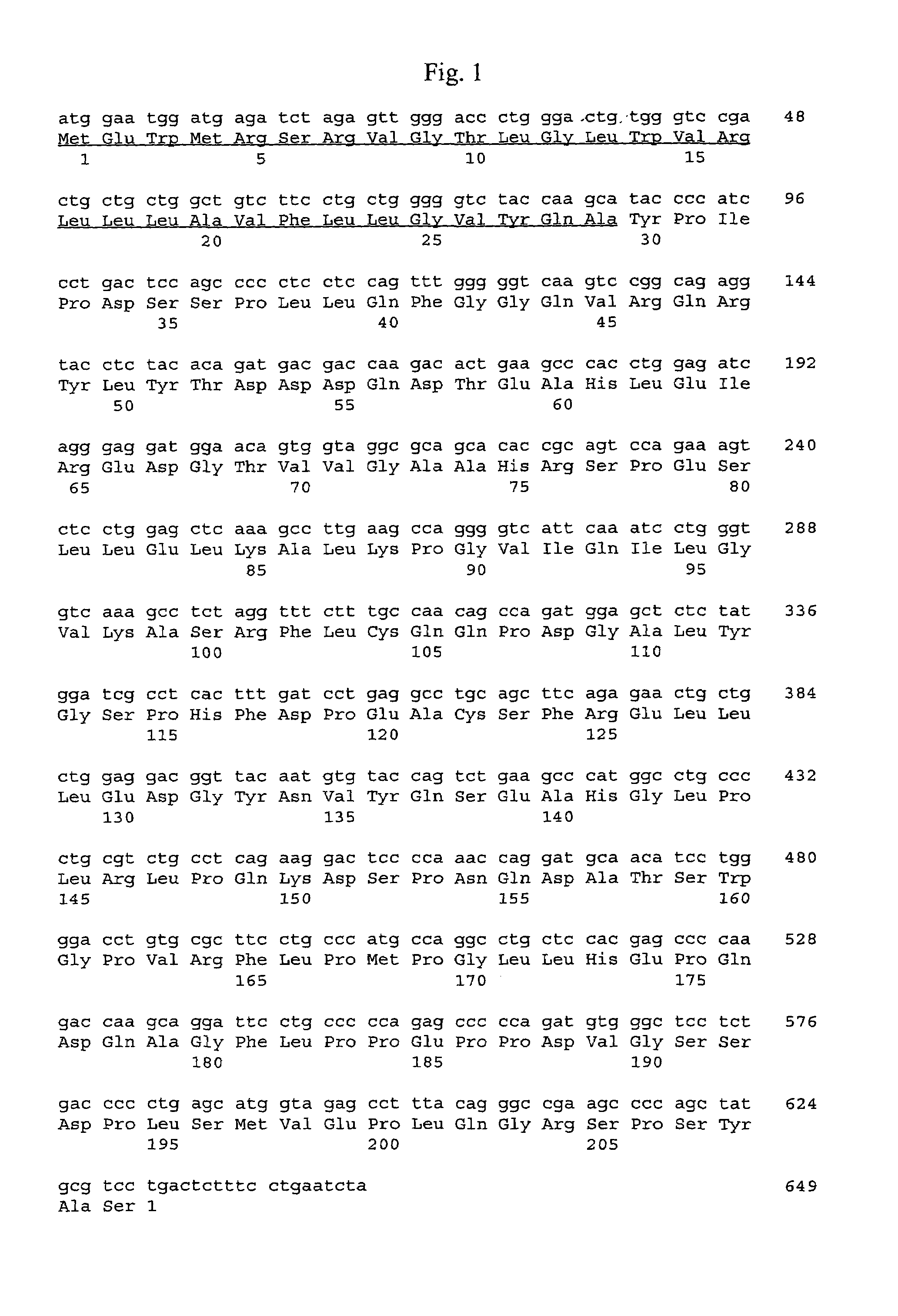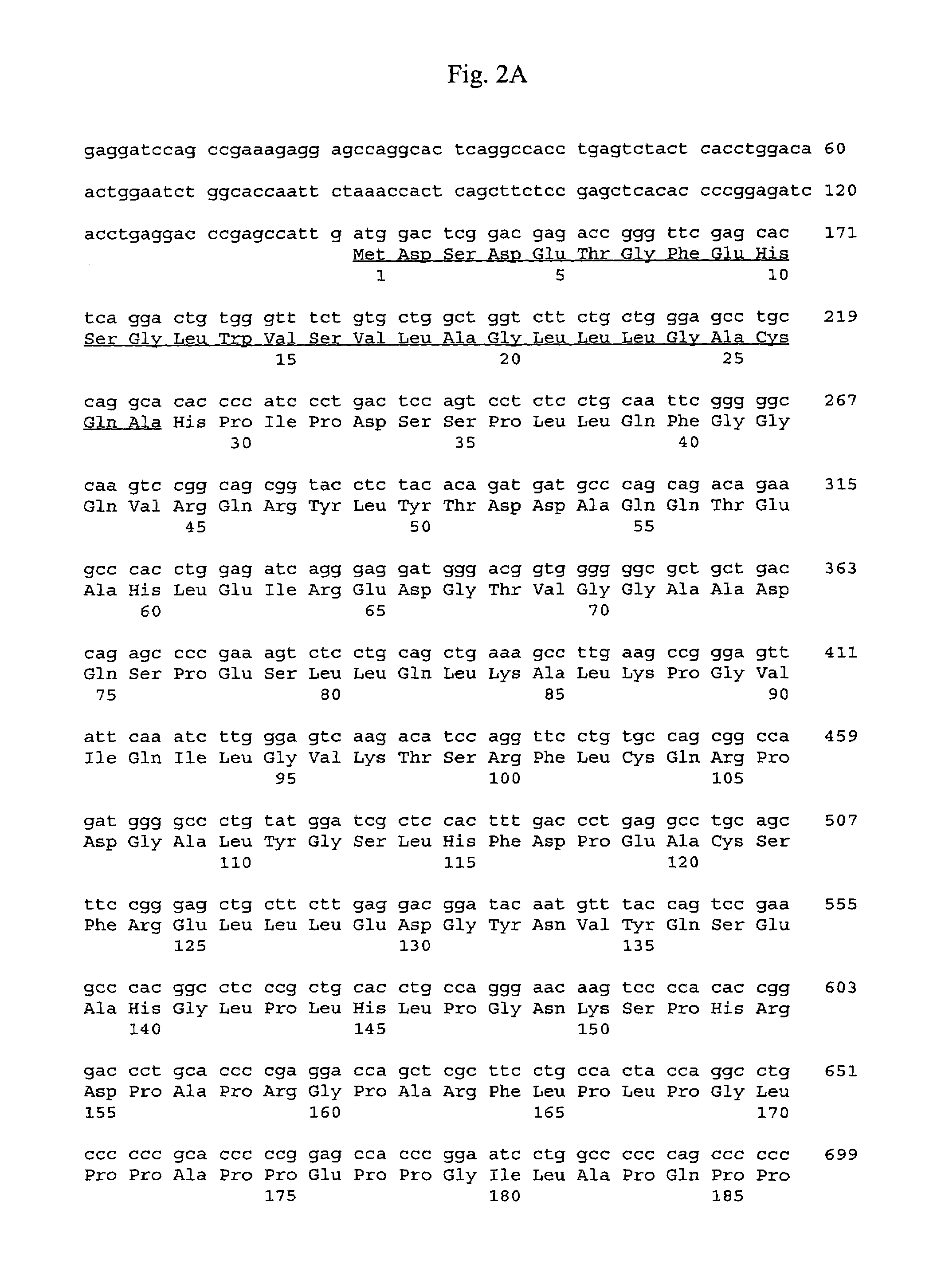Fibroblast growth factor-like polypeptides
a polypeptide and growth factor technology, applied in the field of fibroblast growth factorlike (fgflike) polypeptides, can solve the problems of unrealized potential for novel therapeutics based on the human genome, structural and functional analysis of polypeptide products from many human genes,
- Summary
- Abstract
- Description
- Claims
- Application Information
AI Technical Summary
Benefits of technology
Problems solved by technology
Method used
Image
Examples
example 1
Cloning of the Murine FGF-Like Polypeptide Gene
[0261]Generally, materials and methods as described in Sambrook et al. supra were used to clone and analyze the gene encoding rat FGF-like polypeptide.
[0262]Sequences encoding the murine FGF-like polypeptide were isolated from a mouse regenerating liver cDNA library by screening the library in a kFGF signal trap system (U.S. patent application Ser. No. 09 / 026,958). This primary screening technique enriched for clones encoding signal peptide-containing secreted proteins.
[0263]A primary library (Tmrl1) was constructed in the kFGF vector as follows. Regenerating mouse liver was removed 24 hours after partial hepatectomy, and poly A+ RNA prepared using a commercially available RNA extraction kit and mRNA purification kit (Pharmacia Biotech). A cDNA library was prepared using the SuperScript™ Plasmid System for cDNA Synthesis and Plasmid Cloning (Gibco BRL) with some modifications. First strand reactions were performed using 3 μg of poly A+ ...
example 2
Cloning of the Human FGF-Like Polypeptide Gene
[0280]Generally, materials and methods as described in Sambrook et al. supra were used to clone and analyze the gene encoding human FGF-like polypeptide.
[0281]Sequences encoding the human FGF-like polypeptide were isolated by screening a human cDNA library with a probe derived from the murine FGF-like polypeptide gene. A 460 bp probe was generated by PCR amplification of murine FGF-like polypeptide cDNA using the following primers: 5′-TGGAATG GATGAGATCTAGAG-3′; SEQ ID NO: 7) and 3′ (5′-CATTGCGGCCGCTC AAGATGCAAAACGCAGTG-3′; SEQ ID NO: 9) in reactions containing 32P dCTP. The amplification reaction was performed at 94° C. for 1 minute for 1 cycle; 94° C. for 15 seconds and 65° C. for 1.5 minutes for 35 cycles; and 72° C. for 10 minutes for 1 cycle.
[0282]The 460 bp murine probe was used to isolate a full-length cDNA for human FGF-like polypeptide from a human liver cDNA library. A human liver full-length cDNA library was constructed using s...
example 3
FGF-like mRNA Expression
[0286]Expression of murine FGF-like mRNA was examined on a murine multiple tissue Northern blot (Clontech) using a 32P-dCTP labeled murine FGF-like probe. The probe consisted of a 391 bp fragment isolated from the tmrl1-00001-e9 clone by restriction digestion with Xba I and Not I. The blot was first prehybridized for 2 hours at 42° C. in a hybridization solution consisting of 50% formamide, 5×Denhardt's, 6×SSC, 0.5% SDS, and 100 μg / ml salmon sperm DNA. Following prehybridization, the filters were incubated with the 32P-dCTP labeled murine FGF-like probe overnight at 42° C. in fresh hybridization solution. The filters were then washed with 0.1×SSC / 0.1% SDS at 65° C. and were subsequently analyzed by autoradiography overnight at −80° C. Two transcripts, of approximately 1.35 kb and 1.8 kb, were detected in murine liver (FIG. 4A). The 1.35 kb transcript showed the predominant expression.
[0287]Expression of human FGF-like mRNA was examined on a Human RNA Master B...
PUM
| Property | Measurement | Unit |
|---|---|---|
| pH | aaaaa | aaaaa |
| pH | aaaaa | aaaaa |
| temperature | aaaaa | aaaaa |
Abstract
Description
Claims
Application Information
 Login to View More
Login to View More - R&D
- Intellectual Property
- Life Sciences
- Materials
- Tech Scout
- Unparalleled Data Quality
- Higher Quality Content
- 60% Fewer Hallucinations
Browse by: Latest US Patents, China's latest patents, Technical Efficacy Thesaurus, Application Domain, Technology Topic, Popular Technical Reports.
© 2025 PatSnap. All rights reserved.Legal|Privacy policy|Modern Slavery Act Transparency Statement|Sitemap|About US| Contact US: help@patsnap.com



